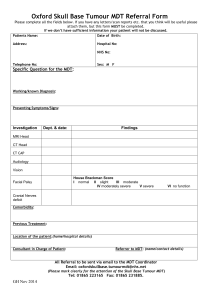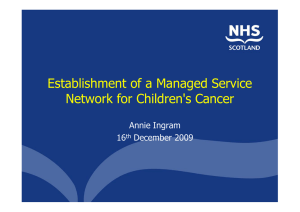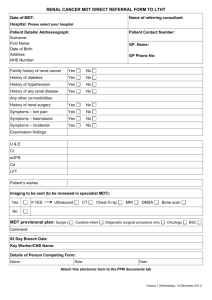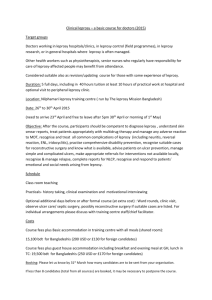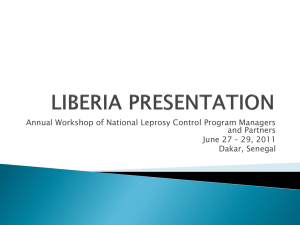Leprosy - one of the few diseases which can be eliminated elimination
advertisement
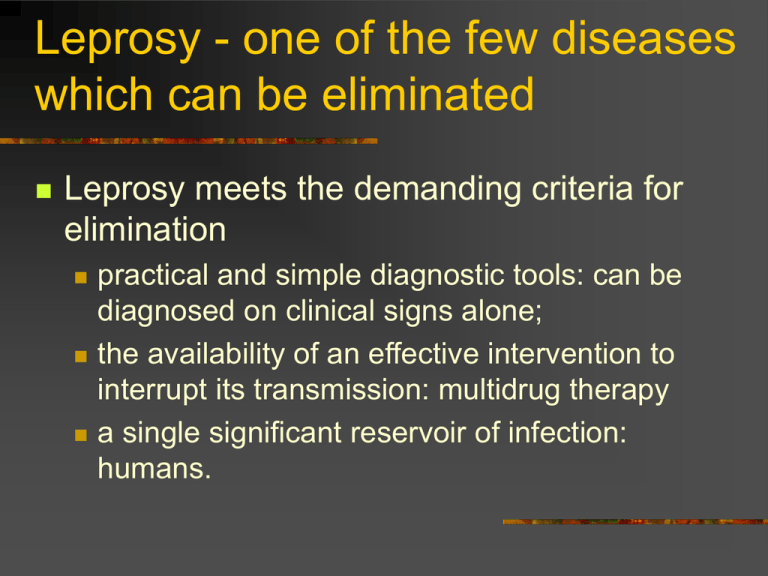
Leprosy - one of the few diseases which can be eliminated Leprosy meets the demanding criteria for elimination practical and simple diagnostic tools: can be diagnosed on clinical signs alone; the availability of an effective intervention to interrupt its transmission: multidrug therapy a single significant reservoir of infection: humans. Why integrate leprosy into the general health services? Integration means to provide “comprehensive” essential services from one service point to improve patients’ access to leprosy services and thereby ensure timely treatment to remove the “special” status of leprosy as a complicated and terrible disease to consolidate substantial gains made to ensure that all future cases receive timely and correct treatment to ensure that leprosy is treated as a simple disease Why is coverage so important? Good coverage means that: health facilities are easily accessible to every member of the community health services are provided on a daily basis health workers are able to diagnose, cure and provide basic information about the disease health facilities are distributed equally in all areas urban/rural, male/female, poor/rich, tribal/others, etc. Advantages of Integrating Leprosy Services Patients detected early Patients treated early Transmission of infection interrupted early Development of deformities prevented Stigma reduced further Diagnosing a case of leprosy We must follow good practices Good practices are: be friendly give correct information about the disease answer questions /doubts keep confidentiality keep up to date records give choice to patient to decide when and where to come back use MDT in a flexible manner provide leprosy services free of cost avoid unnecessary investigations How to diagnose leprosy Examine skin Check for patches Test for sensation Count the number of patches Look for damage to nerves Signs of leprosy Pale or slightly reddish patch Definite loss of sensation in the patch Signs of damage to nerves definite loss of sensation in hands/feet weakness of muscles of hands/feet/face visible deformity of hands/feet/face What is not leprosy Skin patches which have normal feeling are present from birth cause itching are white, black, dark red or silver coloured show scaling appear and disappear periodically spread quickly What is not leprosy (cont.) Signs of damage to hands/feet/face without loss of sensation due to other reasons like injury, accidents, burns, birth defects due to other diseases like arthritis due to other conditions causing paralysis How to examine for leprosy? Examine in a well-lit room Examine the whole body Ask since when the patch was noticed Ask what treatments have been tried Test for sensation Look for any visible deformities Check for loss of sensation Take a pointed soft object (feather, cotton wick) Lightly touch alternately the patch & normal skin Ask the person to point where they were touched Ask them to close their eyes and repeat the procedure In case of loss of sensation the person will be able to point to where they were touched on the normal skin but not on the patch Treating a case with MDT Classification for treatment The diagnosis is made based on finding definite loss of sensation in one or more patches. When you have examined the whole body, count the number of patches. 1-5 patches is paucibacillary (PB), more than 5 patches is multibacillary (MB) leprosy Standard WHO-MDT for the treatment of leprosy Steps to start MDT Classify as PB or MB leprosy Inform the patient about the disease Explain the MDT blister pack - show drugs to be taken once a month and every day Explain possible side effects (e.g. darkening of skin) and possible complications and when they must return to the health centre Ask the patient when it is convenient for him/her to come back to the health centre. Give enough MDT blister packs to last until the next visit. Fill out the patient treatment card Treatment regimens PB Adult (6 blister packs) Rifampicin 600 mg once a month Dapsone 100 mg every day MB Adult (12 blister packs) Rifampicin 600 mg once a month Clofazimine 300 mg once a month Clofazimine 50 mg and dapsone 100 mg every day Multi Drug Therapy Multi Drug Therapy Keeping good records Good records include: Patient identification (name, age, sex, address) Remark on history of complaint (what, how long, progress) Remark on history of previous treatment (what, where, how long, result) Current treatment (diagnosis, classification, any visible disability, date of first dose, date of next appointment) Record of special events (what event, date, how managed, referral) Date of cure Information to patients About the disease Caused by a bacteria Affects skin and sometimes nerves Progresses slowly Easy to diagnose and cure Lead normal life, do not change life style Information to patients About the treatment MDT will cure you completely MDT is free of cost MDT is available in all health centres MDT should be taken as advised (regular, full course) If you have problem or questions contact your health centre Information to patients About possible problems Skin discoloration due to clofazimine Urine discoloration due to rifampicin In case of fever, pain in the nerves, muscle weakness, joint pains they must return immediately to the health centre In case of eye problems Appearance of new skin patches How to protect insensitive hands/feet What is Accompanied MDT (A-MDT)? A patient receives a full course of MDT at the outset receives information (verbal and printed materials) about the disease, its treatment and when and where to come for follow up, and someone close to or important to the patient assumes the responsibility of ensuring that the patient completes a full course of treatment. Note: In some areas (difficult to access, poor security etc) or for some patients (students,workers etc), this will ensure that all patients have adequate supply of MDT at home. Curing the disease Provide the correct blister packs (MB/ PB/ Child/ Adult) for correct duration (6 for PB & 12 for MB) Explain how to use the blister pack (MB or PB) Give the first dose at soon as diagnosis is made Explain about the importance of regular treatment Encourage to ask questions and remove doubts Check when it is convenient to come back to the centre Give enough blister packs to cover the interval Encourage patients to come in case of problems/ doubts MDT side-effects Red coloured urine Darkening of skin This is due to rifampicin. Lasts only for few hours Reassure the patient that this is harmless This is due to clofazimine. Reassure the patient that this will disappear after treatment is completed This is due to allergy to one of the drugs (commonly to dapsone). Stop all medicines and refer to hospital Severe itching of skin How to manage complications Some patients may develop complications Leprosy reactions Side-effects Disabilities Leprosy reactions 1 or 2 patients in 10 may develop reactions Reactions are not a side effect of MDT. They are the body’s response to leprosy More commonly seen in MB cases (more than 5 lesions) Signs and symptoms include Skin: patch/s becomes reddish and/or swollen; sometimes painful reddish nodules appear Nerves: pain in the nerve and/or joint; loss of sensation and weakness of muscles (commonly of hands, feet and around eyes) General: fever, malaise, swelling of hands/feet Managing reactions (1) Early diagnosis and prompt treatment of reactions Every patient should be informed about the signs and symptoms of reactions Inform them to go as soon as possible to the health centre Reassure patients that: reactions can be treated they are not a side-effect to MDT does not mean that MDT is not working Managing reactions (2) Rest is very important: Control of pain and fever Help to get leave from work or school for a few days (e.g. medical certificate) Aspirin or paracetamol Continue MDT regularly Managing reactions (3) Reactions which only involve the skin: rest and pain-killers are usually sufficient. If there is no improvement within few days or worsening, then specific treatment is needed Reactions which involves the nerves start treatment with a course of corticosteroids (e.g. prednisolone) as soon as possible will control all signs/symptoms of reaction Before starting treatment with prednisolone Make sure that you have adequate stock One course will require 336 tablets of 5 mg each The course lasts for 12 weeks It is better to examine the patient once every 14 days and reduce the dose Advise to take the total daily dose every morning If you do not have adequate stock, then start treatment and refer to another centre/hospital Always send a written note with the patient, when you refer Suggested course of prednisolone 40 mg (8 tablets) every morning for 14 days 30 mg (6 tablets) every morning for 14 days 20 mg (4 tablets) every morning for 14 days 15 mg (3 tablets) every morning for 14 days 10 mg (2 tablets) every morning for 14 days 5 mg (1 tablets) every morning for 14 days Note: Continue rest and aspirin or paracetamol as required Examine the patient every 14 days before reducing the dose If there is no improvement or worsening, refer to hospital Continue MDT regularly Why do disabilities occur? Disabilities such as loss of sensation and deformities of hands/feet/eyes occur because: Late diagnosis and late treatment with MDT Advanced disease (MB leprosy) Leprosy reactions which involve nerves Lack of information on how to protect insensitive parts Disabilities can be prevented The best way to prevent disabilities is: early diagnosis and prompt treatment with MDT Inform patients (specially MB) about common signs/symptoms of reactions Ask them to come to the centre ASAP Start treatment for reaction ASAP Inform them how to protect insensitive hands/ feet /eyes Involve family members in helping patients Care of feet Cracks and fissures Blisters Simple ulcer Soak in water Apply cooking oil/Vaseline Use footwear Do not open blister Apply clean bandage Clean with soap & water Rest and clean bandage Care of feet (2) Infected ulcer Wounds/injury Weakness/paralysis Clean with soap & water Rest & apply antiseptic dressing Soak in water Apply cooking oil/Vaseline Clean and apply clean bandage Protect when working/cooking Oil massage Exercises Refer Care of eyes Redness and pain Injury to cornea Difficulty in closing eye Aspirin or paracetamol Atropine and steroid ointment Cover with eye pad Apply antibiotic ointment Refer Tear substitute eye drops Exercises Dark glasses to protect Refer When treatment is completed Congratulate the patient Thank family/friends for their support Reassure that MDT completely cures leprosy Any residual lesions will fade away slowly Show them how to protect anaesthetic areas and/or disabilities Encourage to come back in case of any problem Tell that they are welcome to bring other members of family or friends for consultation Remove the patient’s name from the treatment register
